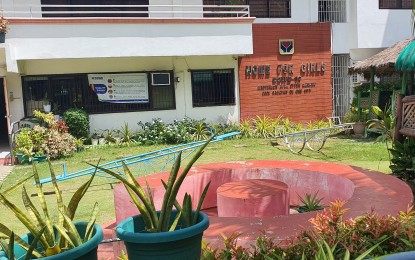
PROTECTING WOMEN, KIDS. The Home for Girls, one of the care facilities of the Department of Social Welfare and Development Region 10 in Cagayan de Oro City. (PNA photo by Nef Luczon)
Part 1 of 2
(Editor's note: Names of the victims are changed or withheld to protect their identities)
CAGAYAN DE ORO CITY - Just over a decade ago, Selva decided to try her luck in this city to help her parents make ends meet and, at the same time, continue her studies. She was 13-years-old.
What started as a dream of a good life became a nightmare when she ended up as a househelp in one of the urban barangays here, where she was raped by the household members.
"I was raped - by the father and his two sons," Selva, now 35, said during an interview Thursday.
She didn't lose hope, fighting the perpetrators in court and managed to have them convicted and jailed.
For other rape victims, however, justice was not swift enough, as it did to Selva.
In terms of crimes involving women and children, rape cases remain on top in the Northern Mindanao region, according to the Police Regional Office-10 (PRO-10).
From January 1 to September 30 this year alone, a total of 288 cases in violation of the Republic Act (RA) 8353, or the "The Anti-Rape Law of 1997," have been filed in the courts.
Of the number, a total of 202 of which have suspects served with warrants of arrest by the police.
Late reporting
PRO-10 spokesperson PMaj. Joann Navarro said several rape cases were reported late, or it took some time for survivors to have courage and seek help.
"Although data during the time of the Covid-19 pandemic, between 2020-2021, the child abuse (and rape) cases reported have decreased, we are still looking at the possible factors of that decrease - maybe they (the survivors) have no access in reporting (the incidents) because of the quarantines," Navarro said.
Navarro, speaking from experience as the former chief of the Women and Children Protection Desk under the Misamis Oriental Police Provincial Office, said some rape cases are reported five or six years after the incident happened.
The PRO-10 data showed cases related to RA 7610 or the "Special Protection of Children Against Abuse, Exploitation, and Discrimination Act" ranked second.
A total of 235 cases were filed and 121 warrants of arrest were served by the police.
This was followed by acts of lasciviousness, with 78 cases filed, four cases of attempted rape, three cases of sexual assault, and one case of child pornography under RA 9775.
Home for girls
At the Region 10 field office of the Department of Social Welfare and Development (DSWD-10), a facility called "Home for Girls" was built to shelter abused children.
Selva used to stay here for two years while her case was being tried in court.
"We used to do gardening, and were taught sewing and pedicure while others studied," she said.
Daisy Ramos, Sectoral Unit Head in DSWD-10, said one of the goals inside the facility is to provide care for sexually abused children while their cases are ongoing in the courts.
"It also aims to reunify them (the survivors) with their families once their cases are resolved," she said.
Ramos also said even those who survived the abuses remained "endangered" in their communities because some cases involved perpetrators who were also relatives.
In its 3rd Quarter report, DSWD-10 social worker Grace Dael recorded 59 wards at the Home for Girls.
Along with other care facilities, children living there were given health, medical and dental services through regular consultation, and tapping other medical services from government and private hospitals.
They were also exposed to recreational, sociocultural activities and spiritual activities.
Dael said psychosocial services are also provided through counseling and therapeutic conversation, behavioral assessment, developmental assessment, and psychological evaluation.
They also provide home-life services through one-on-one care and substitute parental care, and teaching the children about home management and values inculcation, she added.
Web of trafficking
Although the data from PRO-10 showed no trafficking cases filed from January 1 to September 30, Ramos said the DSWD has recorded past cases involving children as victims.
During the forum organized by the non-government organization, World Vision in July this year, the Department of Justice noted that in Region 10, most trafficking survivors prefer not to report the incident.
Assistant City Prosecutor Louie Borja earlier said trafficking survivors, particularly children, usually do not report illegal activities to authorities.
“For the reason that most of them (victims) see the traffickers as a source of income. These children are disinterested complainants,” Borja said during a multidisciplinary stakeholders' training.
Oliver Inodeo, a DSWD-10 focal person, said trafficked children are subjected to different forms of abuse, but most of the time, it is in the form of unpaid labor, sexual abuse, or prostitution.
With advanced online technology, however, Inodeo said trafficking cases and sexual abuses of children have opened a new challenge for law enforcers, advocates, and social workers. (To be continued) (PNA)
